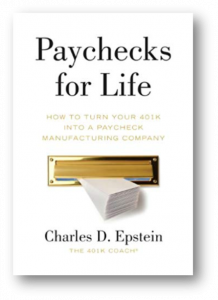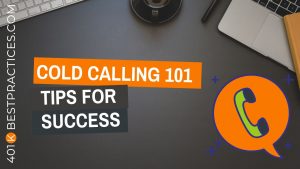Cold Calling 101 – Tips for Success
If you’ve been in touch with your prospects via email, often included in a marketing plan is to reach out and actually start a conversation (as in – pick up the phone and give them a call 😉 ).
Calling prospects on the phone can be challenging though, especially if they haven’t given you permission to send them information, they’re not on your email list, and they have no idea who you are.
In this article, we’ll cover cold calling, otherwise known as telemarketing, and we’ll go over some tips to make this prospecting method more effective.
Telemarketing Psychology
To have success when cold calling, the first thing you need to understand is that there’s a psychology to telemarketing.
First off, telemarketing is not a numbers game – it’s a relationship game – it’s a relationship SALE.
It’s about building a relationship, finding out if you’re a fit for each other, identifying their value system and getting them to have enough interest in what you’re saying that they’re willing to take your relationship to the next level.
You have to invest time and effort in order for any relationship to be equally valuable to both parties – and in the 401k market, it’s no different.
Telemarketing works, only if you understand these seven key points:
That the market is extremely competitive and crowded and the sales cycle is LONG – which is why you have to invest in the relationship – don’t expect to make it to third base on the first date. The typical sales cycle is 9 months in the small market and up to 2 years for larger plans so don’t be discouraged if things don’t move fast – if you’re lucky enough to get the “first date” your batting average is higher than most.
Even though 401k products are viewed as a commodity by plan sponsors, the 401k plan sale is not a transactional sale – it’s a relationship sale and throwing around terms like fiduciary, funds, and fees – taking the doom and gloom approach – will get you seen as a salesman rather than an advocate or partner. (Not to say that you can’t discuss these things – you just don’t want to use them as a scare tactic when prospecting.)
A company retirement plan is typically not a priority for plan sponsors. And most small business owners are risk takers – they take calculated risks all the time so they’re not scared by the doom and gloom approach since the odds of a broken plan blowing up have always been in their favor. Until now…With the recent audit activity the DOL has initiated, including a target audit of all retirement plans as a goal, an educated and informed plan sponsor might be more inclined to actually listen to any suggestions you might have to ensure their plan is operating in accordance with prevailing standards.
Through education you can create demand – which is what you must do in order to get plan sponsors to understand they even have a problem or need your services. This is what building the relationship is all about.90% or more of all plans you’re introduced to won’t have a need and you’ll spend the first few months building your relationship and convincing them that they need to make it a priority to review, upgrade or change their plan or plan providers.
Another thing that’s important to understand if you’re to be successful cold calling is this – rejection, is going to happen – a lot. If you go into this strategy understanding that, it becomes much easier to simply track the data and know your numbers and keep dialing and having conversations until you’re able to reach enough people that are willing to start a relationship with you.
Also, keep in mind that the gatekeeper is not your enemy. The gatekeeper is human and can be won over if you’re polite, pleasantly persistent, and personable.
And finally, it’s no secret that often prospects can be hostile (you might be too if you had advisors calling you daily) so if you don’t find this enjoyable, easy, and effortless – don’t do it. I’d recommend finding another method that suits you better or consider outsourcing the lead generation to a firm that specializes in telemarketing in the retirement industry.
Telemarketing Strategies
If, after understand the telemarketing psychology, you choose this method for generating leads, then here are six strategies that can make calling more effective:
1. GRAB A COPY OF “THERE’S NO SUCH THING AS CLOSING THE DEAL: A BRIEF(CASE) GUIDE TO SUCCESSFUL SALES ” BY JANE MURPHY
” BY JANE MURPHY
Jane Murphy was responsible for growing sales in Fidelity’s small-to-mid sized 401k division from $100k to more than $2 billion in new assets every year she was there (all over the phone with her call center!). She is the expert at how to grow a 401k business through telemarketing and her book, while a short read, is chock full of tips and ideas you should know if you want to succeed at growing your business through outbound calling. AND most of the tips in this article came directly from Jane.
2. IDENTIFY YOUR NICHE/UNIQUE VALUE
It’s important to be clear on who you serve and how you’re different; understanding that “companies that offer a 401k plan” is not a defined niche and neither is “companies that have more than $10 million in plan assets.” You need to be a clear choice to a clear type of client or plan or challenge, and then you need to be able to define how your process is different or better than that of your competition.
3. IDENTIFY A WISH LIST OF 50 PROSPECTS THAT FIT THE PICTURE OF YOUR IDEAL CLIENT TYPE AND DO YOUR RESEARCH
Research the prospects you’d like to talk to. Research helps you understand what challenges the business and plan might be facing, who the decision makers are that you need to reach out to, and how you might connect with them prior to calling on them.
The one thing that will have the most impact on your success is data. It’s imperative that you start with intelligent data before calling out to plan sponsors.
Start with a list of 50 people that you’ve identified as plan’s you’d love to have as clients – because they’re a good fit for your business and you’ve identified your niche (not because they’re local, big plans, money in the bank, an opportunity to get a plan – they must fit the profile of your ideal demographic / your ideal client).
Once you have this list, then it’s time to start the process of conducting research. Since most plan sponsors don’t have a need and your job is to create demand, it helps to review data you gather with an eye for opportunities.
Pull a copy of the 5500 to identify plan costs, investments and providers. Identify if the company recently made a change to the providers on their plan (if so, they’re probably not going to change again right away so data gathering can save you time on chasing the wrong rabbit).
Go to their company website and their LinkedIn page and gather some basic information such as their market cycle, company growth, and philanthropic activities.
See if you have a connection in common with the key decision maker that might be able to make an introduction or if you have any of the same interests or organizations in common with any of the individuals who are listed in the 5500. Many advisors outsource this to an intern and have a simple spreadsheet put together that provides critical elements that are important to know ahead of meeting with a plan sponsor.
Finally, it’s important to ensure the data you have is the most current and accurate. A lot of advisors, once they’ve selected the plans they want to go after, buy their contact information and market intelligence data direct from firms like Acceleration Retirement who own proprietary databases with industry-specific information available.
4. CREATE A COLD-TO-WARM LEAD PRE-SELL STRATEGY
Think about how you can get your name in front of your prospects and start to build credibility, value, and goodwill before expecting them to give you anything, including their time.
One of the most effective methods for earning an opportunity to start a relationship with a prospect is by first turning the cold call into a warm call.
One great example of this comes from Charlie Epstein, the 401k Coach, who said that you must make a deposit into the relationship.
“No deposit, no withdrawal.”
 Send the prospect a book, like Charlie’s Paychecks for Life book with a sticky note stating you thought they might like this – then follow it up with a phone call once you know they’ve received it.
Send the prospect a book, like Charlie’s Paychecks for Life book with a sticky note stating you thought they might like this – then follow it up with a phone call once you know they’ve received it.
Another suggestion is to send a book directly from AMAZON and have it gift wrapped. While the gatekeeper might open the box, they’re typically not going to unwrap the book and it will create curiosity on the part of the recipient. Sending something valuable that the prospect truly might find interesting and relevant to their role as a plan sponsor is one way to get your foot in the door.
People won’t remember the four advisors that called asking to talk to them about their plan but will remember the guy that sent that book. Creating a memorable experience warms up a cold lead and gives you at least an opportunity to ask for a meeting.
When I was an active advisor, we’d send prospects a red, fortune-telling 8-ball with the words, “Do you have a successful plan?” printed on it and then followed up with a call (it was very effective by the way).
I even heard the story once of a guy that sent a box with a boot in it along with a note that said “I’ve been trying to get my foot in the door for a year to talk to you about your plan.” It resulted in a chuckle and an appointment.
Another great strategy is to use LinkedIn to connect.
I don’t mean just finding the profile of the individual you hope to meet and asking for a connection.
First, view their profile – this shows up in their newsfeed and 80% of folks will view your profile back to see who’s looking at them.
See what groups they belong to or their interests and see if you have any in common. You might find that you have a lot in common.
Actively participate in groups that you share and consistently provide value and contribute thoughtful comments in those groups.
If they use the publishing option, you can follow them and their posts will show up in your feed. Comment, if appropriate, on their posts and use LinkedIn as a way for them to get to know you through your interactions.
I recently read an article that shows how a little LinkedIn research can go a long way. The article is written by James Altucher and is titled “How to Use LinkedIn to Read Minds and Make Money (True Story).” I’d recommend giving it a quick read, mostly for fun, but also for the quirky lesson on the benefits of a little detective intelligence.
5. BUILD A RELATIONSHIP
As you connect with your prospects, focus your conversations on identifying their goals and value drivers and always be working towards the next appointment that allows you to offer additional value and build a relationship rather than a quick jump to try to close the deal.
The 401k business is a relationship business so spread out your sales process to allow time to earn trust and show value.
6. CREATE A PIPELINE MANAGEMENT PROCESS
Create a process that helps you to systematize your pre-sell, appointment, and post-meeting procedures. Include an ongoing drip process to continue to add value and build credibility to keep hot prospects from turning cold since the sales cycle in the 401k industry is a long one and 12-18 months is often the length of time it takes before a prospect becomes a client.
WILL IT WORK?
Ultimately the success you have will depend on many factors, including how well you’re able to create and follow a prospecting strategy that includes the steps we’ve just discussed.
However, if you don’t enjoy cold calling (I know of few individuals that do), I’d recommend either outsourcing the lead generation and calling to a firm like Acceleration One (Formerly Acceleration Retirement) that has the resources and track record of helping advisors build a 401k business through their experienced call center… or find a different prospecting method altogether ;-).
Effective 401k Prospecting Strategies
This article is part of a series covering effective 401k Prospecting Strategies. You can access the full series using the links below:
Listen to the Podcast episode of this topic here (coming soon).Or watch the video on YouTube here (coming soon).
Affiliate Disclaimer: As an Amazon Affiliate, if you make a qualifying purchase on Amazon, I may receive a commission (at no extra cost to you). I only recommend books I’ve read and feel you can benefit from.
























